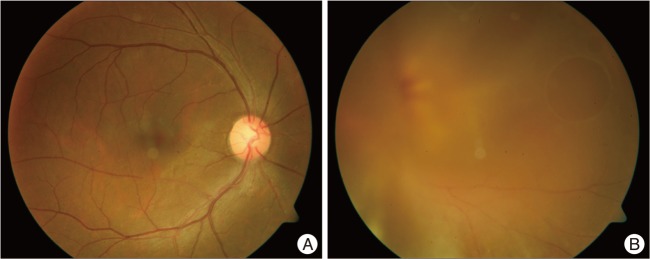J Korean Neurosurg Soc.
2012 Jun;51(6):367-369. 10.3340/jkns.2012.51.6.367.
Terson Syndrome Caused by Intraventricular Hemorrhage Associated with Moyamoya Disease
- Affiliations
-
- 1Department of Neurosurgery, School of Medicine, Pusan National University, Busan, Korea. sangweonlee@pusan.ac.kr
- 2Department of Neurosurgery, School of Medicine, Ewha Womans University, Seoul, Korea.
- KMID: 2190492
- DOI: http://doi.org/10.3340/jkns.2012.51.6.367
Abstract
- Terson syndrome was originally used to describe a vitreous hemorrhage arising from aneurysmal subrarachnoid hemorrhage. Terson syndrome can be caused by intracranial hemorrhage, subdural or epidural hematoma and severe brain injury but is extremely rare in intraventricular hemorrhage associated with moyamoya disease. A 41-year-old man presented with left visual disturbance. He had a history of intraventicular hemorrhage associated with moyamoya disease three months prior to admission. At that time he was in comatose mentality. Ophthalmologic examination at our hospital detected a vitreous hemorrhage in his left eye, with right eye remaining normal. Vitrectomy with epiretinal membrane removal was performed. After operation his left visual acuity was recovered. Careful ophthalmologic examination is mandatory in patients with hemorrhagic moyamoya disease.
MeSH Terms
Figure
Reference
-
1. Arakawa Y, Goto Y, Ishii A, Ueno Y, Kikuta K, Yoshizumi H, et al. Terson syndrome caused by ventricular hemorrhage associated with moyamoya disease--case report. Neurol Med Chir (Tokyo). 2000; 40:480–483. PMID: 11021082.
Article2. Ballantyne AJ. The ocular manifestations of spontaneous subarachnoid hemorrhage. Br J Ophthalmol. 1943; 27:383–414. PMID: 18169953.3. Clarkson JG, Flynn HW Jr, Daily MJ. Vitrectomy in Terson's syndrome. Am J Ophthalmol. 1980; 90:549–552. PMID: 7424753.
Article4. Frizzell RT, Kuhn F, Morris R, Quinn C, Fisher WS 3rd. Screening for ocular hemorrhages in patients with ruptured cerebral aneurysms: a prospective study of 99 patients. Neurosurgery. 1997; 41:529–533. discussion 533-534. PMID: 9310968.
Article5. Garfinkle AM, Danys IR, Nicolle DA, Colohan AR, Brem S. Terson's syndrome: a reversible cause of blindness following subarachnoid hemorrhage. J Neurosurg. 1992; 76:766–771. PMID: 1564539.
Article6. Hedges TR Jr, Walsh FB. Optic nerve sheath and subhyaloid hemorrhage as a complication of angiocardiography. AMA Arch Ophthalmol. 1955; 54:425–427. PMID: 13248305.
Article7. Kuhn F, Morris R, Witherspoon CD, Mester V. Terson syndrome. Results of vitrectomy and the significance of vitreous hemorrhage in patients with subarachnoid hemorrhage. Ophthalmology. 1998; 105:472–477. PMID: 9499778.8. Manschot WA. Subarachnoid hemorrhage; intraocular symptoms and their pathogenesis. Am J Ophthalmol. 1954; 38:501–505. PMID: 13197505.9. McCarron MO, Alberts MJ, McCarron P. A systematic review of Terson's syndrome : frequency and prognosis after subarachnoid haemorrhage. J Neurol Neurosurg Psychiatry. 2004; 75:491–493. PMID: 14966173.
Article10. Miyamoto S, Kikuchi H, Karasawa J, Nagata I, Ihara I, Yamagata S. Study of the posterior circulation in moyamoya disease. Part 2 : Visual disturbances and surgical treatment. J Neurosurg. 1986; 65:454–460. PMID: 3760953.11. Muller PJ, Deck JH. Intraocular and optic nerve sheath hemorrhage in cases of sudden intracranial hypertension. J Neurosurg. 1974; 41:160–166. PMID: 4366848.
Article12. Noda S, Hayasaka S, Setogawa T, Matsumoto S. Ocular symptoms of moyamoya disease. Am J Ophthalmol. 1987; 103:812–816. PMID: 3591879.
Article13. Ogawa T, Kitaoka T, Dake Y, Amemiya T. Terson syndrome : a case report suggesting the mechanism of vitreous hemorrhage. Ophthalmology. 2001; 108:1654–1656. PMID: 11535467.14. Pfausler B, Belcl R, Metzler R, Mohsenipour I, Schmutzhard E. Terson's syndrome in spontaneous subarachnoid hemorrhage : a prospective study in 60 consecutive patients. J Neurosurg. 1996; 85:392–394. PMID: 8751622.
Article15. Roux FX, Panthier JN, Tanghe YM, Gallina P, Oswald AM, Mérienne L, et al. [Terson's syndrome and intraocular complications in meningeal hemorrhages (26 cases)]. Neurochirurgie. 1991; 37:106–110. PMID: 1852236.16. Schultz PN, Sobol WM, Weingeist TA. Long-term visual outcome in Terson syndrome. Ophthalmology. 1991; 98:1814–1819. PMID: 1775315.
Article17. Swallow CE, Tsuruda JS, Digre KB, Glaser MJ, Davidson HC, Harnsberger HR. Terson syndrome : CT evaluation in 12 patients. AJNR Am J Neuroradiol. 1998; 19:743–747. PMID: 9576666.18. Vanderlinden RG, Chisholm LD. Vitreous hemorrhages and sudden increased intracranial pressure. J Neurosurg. 1974; 41:167–176. PMID: 4842785.
Article19. Weaver RG, Davis CH Jr. Subhyaloid hemorrhage. Am J Ophthalmol. 1961; 52:257–259. PMID: 13783552.
Article20. Wiethölter S, Steube D, Stotz HP. [Terson syndrome : a frequently missed ophthalmologic complication in subarachnoid hemorrhage]. Zentralbl Neurochir. 1998; 59:166–170. PMID: 9816667.
- Full Text Links
- Actions
-
Cited
- CITED
-
- Close
- Share
- Similar articles
-
- Incidence and Postoperative Visual Outcome of Terson's Syndrome
- A Case of Moyamoya Disease with Severe Preeclampsia
- Moyamoya Disease with Intraventricular Hemorrhage in a Child
- Rapid Progression of Cerebral Infarction after Intraventricular Hemorrhage in Adult Moyamoya Disease
- Terson's Syndrome due to Subarachnoid Hemorrhage after Rupture of MCA Bifurcation Aneurysm





